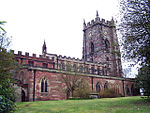Market Drayton railway station
Disused railway stations in ShropshireFormer Great Western Railway stationsMarket DraytonPages with no open date in Infobox stationRailway stations in Great Britain closed in 1963 ... and 2 more
Railway stations in Great Britain opened in 1863Use British English from November 2017

Market Drayton railway station served the town of Market Drayton in Shropshire, England, between 1863 and 1963. It was at the junction where three railway lines met: two of them, forming the Great Western Railway route between Wellington (Shropshire) and Crewe, were met by a line from Stoke-on-Trent on the North Staffordshire Railway.
Excerpt from the Wikipedia article Market Drayton railway station (License: CC BY-SA 3.0, Authors, Images).Market Drayton railway station
Cheshire Street,
Geographical coordinates (GPS) Address Nearby Places Show on map
Geographical coordinates (GPS)
| Latitude | Longitude |
|---|---|
| N 52.9095 ° | E -2.4891 ° |
Address
Cheshire Street
TF9 3AH
England, United Kingdom
Open on Google Maps







